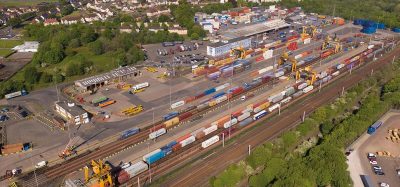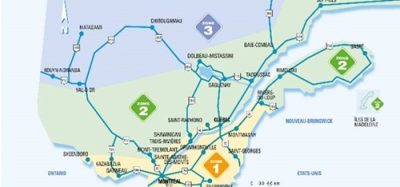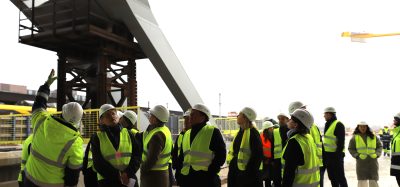Endless growth opportunities for freight
Posted: 28 November 2006 | | No comments yet
Rail freight’s prospects in Britain are very positive. We are already forecasting a growth of 50% by 2014 on top of the 70% growth achieved since the mid 90s but the increasing importance of a sustainable transport system point to even bigger opportunities. The environmental benefits of rail have always been recognised – four times more energy efficient than road and producing one-tenth of the polluting emissions per tonne moved. But as global warming and climate change preoccupy governments and voters alike, the benefits of using rail to transport goods are recognised by senior politicians in all political parties. EWS knows that its customers will not buy its services on environmental benefit alone – we must also provide the right economics and logistics solution to meet their transport needs. Our 100 million tonne portfolio is testament to EWS’s ability to meet those needs.
Rail freight’s prospects in Britain are very positive. We are already forecasting a growth of 50% by 2014 on top of the 70% growth achieved since the mid 90s but the increasing importance of a sustainable transport system point to even bigger opportunities. The environmental benefits of rail have always been recognised – four times more energy efficient than road and producing one-tenth of the polluting emissions per tonne moved. But as global warming and climate change preoccupy governments and voters alike, the benefits of using rail to transport goods are recognised by senior politicians in all political parties. EWS knows that its customers will not buy its services on environmental benefit alone – we must also provide the right economics and logistics solution to meet their transport needs. Our 100 million tonne portfolio is testament to EWS’s ability to meet those needs.
As the ‘E’ in EWS becomes more European than English it is timely to reflect on the opportunities for rail freight in both Britain and Europe.
Rail freight’s prospects in Britain are very positive. We are already forecasting a growth of 50% by 2014 on top of the 70% growth achieved since the mid 90s but the increasing importance of a sustainable transport system point to even bigger opportunities. The environmental benefits of rail have always been recognised – four times more energy efficient than road and producing one-tenth of the polluting emissions per tonne moved. But as global warming and climate change preoccupy governments and voters alike, the benefits of using rail to transport goods are recognised by senior politicians in all political parties. EWS knows that its customers will not buy its services on environmental benefit alone – we must also provide the right economics and logistics solution to meet their transport needs. Our 100 million tonne portfolio is testament to EWS’s ability to meet those needs.
Focusing on those needs has led EWS to its biggest structural change in ten years with the creation of four customer focused businesses: EWS Energy, EWS Industrial, EWS Construction and EWS Network. No longer will rail freight customers have to put up with a ‘one size fits all’ logistics solution. Instead they will be dealing with experts in their particular market – people who understand the needs of their customers and their customers’ customers.
We should not forget EWS’s achievements in the last ten years with over £600m invested in rail freight including the acquisition of 280 new locomotives and over 3,000 wagons. But freight transport is a business where standing still is not an option and EWS will become even stronger as it improves labour productivity, cost control measures and enhances asset utilisation. We will enhance customer service and drive service reliability through front line staff being accountable for service delivery enabling EWS to compete even more effectively with road and rail based competition. This will lead to profitable rail freight growth in Britain and mainland Europe providing a more sustainable way of transporting freight, further enhancing rail’s inherent environmental advantage over other transport modes.
And it is in mainland Europe where some of the greatest opportunities exist. The movement of manufacturing to Eastern Europe creates additional demands for transportation whilst distribution is now seen on a European scale, not just focused on individual countries. The days of a transport hub in each country are passing – instead a single distribution point within Europe lends itself to increased use of rail.
But rail has to respond and knock down the artificial barriers (known as national borders) to matching and beating the performance of other transport modes. No longer can any rail freight operator think of itself purely as a national transport provider – success in the future will come to those who embrace the concept of international operation.
In 2004, EWS decided that European expansion should be a key part of its strategy. Turning the theory into practice has been a challenge but in December 2005 EWS’s European subsidiary, Euro Cargo Rail, operated its first rail freight service in northern France. Since that day, Euro Cargo Rail has gone from strength to strength. It is now operating regular services of aggregates and grain with its Vossloh locomotives and the arrival of Class 66 locomotives will allow the addition of a range of traffics to the portfolio. Additional drivers have been recruited and their enthusiasm for a company that provides a high quality of service that adds value to the customers’ needs is unbounded.
Euro Cargo Rail now has access rights across the whole of France. The award of a safety certificate in Germany and impending approval in Belgium means that its business reach is unparalleled amongst the new entrants in mainland Europe.
And Europe also provides a significant opportunity for the growth of Axiom Rail, EWS’s engineering and manufacturing subsidiary that has quickly established itself as an industry leader. But Europe is only one part of a portfolio that will reach across the world – the opportunities for selling engineering excellence in the far East are endless and are indicative that the railway industry is now global in nature.
But not all is well. Given rail freight’s overpowering environmental credentials we would have expected strong support for expansion and yet there are surprising pockets of resistance where policy will undermine rail freight growth.
Of greatest concern in Britain is the suggestion that the access charges that freight pays to use the network could be doubled. The Office of Rail Regulation (ORR) is examining freight charges as part of its Periodic Review 2008. This review looks at Network Rail’s expenditure in the period from 2009 to 2014 and sets access charges to reflect those costs. The focus on Network Rail’s spending and its efficiency is crucial if we are to have an affordable railway – the key to this is international benchmarking and the shameless copying of world best practice in infrastructure provision. For example, the rail industry is at one in agreeing that there is major potential from increases in possession productivity.
Given these major efficiency opportunities, EWS sees no justification for increasing freight charges; indeed the necessity of encouraging rail freight growth for both sustainability and economic reasons justifies a significant reduction. Instead there seems to be a view at ORR that freight charges should increase. Such a policy can put at risk the traffic that EWS has won to rail let alone the growth potential. The next few months will see EWS pointing out the folly of increased charges whilst focusing on the way in which Network rail can reduce its costs. Perhaps the time has come for Network Rail to relinquish control of the Freight-only lines, alleged to be one of the primary drivers of freight costs.
Equally bizarre are the proposals by the UK Treasury to increase the duty on the fuel used by EWS in its locomotives by nearly 20% – at a time when fuel prices have more than doubled. If this increase is implemented, rail freight’s fuel duty will have increased by 300% in less than ten years. Given the strong political support given to rail freight by the Department for Transport this policy to deliberately increase the costs of freight by rail has little justification.
Turning to Europe our biggest challenge may be getting to Europe rather than what we do when we get there!
By the time this article appears in print we very much hope that the issues surrounding the economics of the Channel Tunnel have been resolved. EWS, through its associated company English Welsh & Scottish Railway International Limited (EWSI) has been operating Channel Tunnel services for nearly ten years, before that time they were operated by British Rail’s subsidiary Railfreight Distribution. The opportunities for international business through the tunnel are massive and yet a series of setbacks have limited the growth. The fire in the tunnel shortly after opening hampered the rail freight start up but the biggest blow was the Asylum Seeker crisis of 2000 when freight services virtually ceased for a year after illegal immigrants sought to convert them into passenger trains. Enhanced security and the demolition of the Sangatte refugee camp resolved the crisis but not before customer confidence was hit. Since then, there has been a gradual restoration of traffic but this was put at risk by the need to resolve the economics of using the tunnel when EWSI’s existing arrangements with the UK Government cease at the end of November.
We are hopeful that a three-way solution involving the UK Government, Eurotunnel and EWSI will produce a solution that makes operating through the tunnel affordable. If so, we confidently expect that the existing 1.6 million tonnes of traffic will increase to eight million tonnes by the middle of the next decade. Even this will only be a small proportion of the 60mt that crosses the Channel each year but it will bring significant environmental benefits to the UK.
Tied to resolving the Channel Tunnel issues is the need to ensure that freight can use the Channel Tunnel Rail Link when it opens in 2007. The Link was built to accommodate freight traffic recognising that this is the only line in Britain that can accommodate the higher and wider loading gauge that can be found in mainland Europe. No longer will customers have to cram their goods into the specialised wagons used in Britain – the prospect of moving pallets stacked three-high by rail into East London will open up markets that have just been dreams for the past 150 years. White goods, automotive components, food and drink will be within the reach of EWS. First, though, we have to be sure that the prices for using the Link are affordable. There will be severe disappointment if access charges are set at a level to deter freight – we await the pricing proposals with keen interest.
Growth is good news but accommodating that growth on the network is a challenge – whether in Britain or in mainland Europe.
Thinking small by adding a wagon here or a wagon there helps capacity to a certain extent, but will do very little to meet rail freight’s longer term capacity needs. The convoluted and bureaucratic process for increasing the payload of a 2,000 tonne train by 70 tonnes is extremely frustrating for an infrastructure provider and an operator alike. This is not the way forward.
Nor are the proposals for brand new routes. Whilst their proposers may claim the epithet of ‘visionary’ the reality is that the planning, funding and building cycle means that the construction of such routes is at least fifteen years away. The salutary experience of Thameslink 2000 and, more recently, Crossrail demonstrates that building new infrastructure is a time-consuming challenge – especially when schemes such as Crossrail fail to recognise the needs of all users of the network.
We must also challenge the lobbyists for the road haulage industry who claim that the rail system is full to capacity and that the only solution to increased freight demand is a return to the road-building of the seventies and eighties – a time when the only interest in global warming was a hope that it increased the chance of sunshine on holiday.
Instead, EWS is pursuing a middle course – the Big Freight Railway. We like to think of it as a practical, affordable vision that ensures that the British network can accommodate the inexorable growth of rail freight. Our philosophy is that the critical asset is the train path. Buying locomotives and wagons and developing terminals are all within the power of the industry but a train path is a scarce commodity. Therefore we need to pack as much into that path as possible and use it effectively.
How should we do this?
- Make freight trains as long as possible – we are currently operating 4,000 tonne coal trains with 42 high capacity wagons. What is stopping us going even longer?
- Make freight trains higher and wider – we should not limit our gauge aspirations to the Channel Tunnel Rail Link. A route that takes mainland European gauge wagons from London to the West Midlands, North West and Yorkshire will open up European markets to the manufacturing heart of Britain
- The maximum axle weight in Britain is just over 25 tonnes, even lower in mainland Europe. In North America where the freight railways are expanding and profitable the average axle weight is 36 tonnes. We need infrastructure in Europe, especially where bulk commodities prevail, that matches North American standards
At a time when countries such as Holland and Sweden are talking openly about 60 and 80 tonne lorries we must open the railway in Britain and mainland Europe to the productivity opportunities that higher, wider, heavier and longer will provide. At the moment the Big Freight Railway is an initiative focused on Britain but through EWS’s membership of the Community of European Railways and the European Rail Freight Association we are pushing the ideas to a wider audience.
And so, just over ten years after EWS was formed what are the prospects for the future? There are issues to overcome such as access charges, fuel duty and tunnel economics, which relate primarily to imposed external costs. Reinforcing our customer focus through Euro Cargo Rail, EWS Energy, EWS Industrial, EWS Construction and EWS Network will further reinforce our market leadership. The demand for a sustainable transport system will further reinforce the economic benefit that our customers enjoy from using rail freight. The growth opportunities are endless – the only limitations are the boundaries of our own imagination.






